The Divided Stage: Splitting the Dialectics of Performance
by Pil and Galia Kollectiv
Walter Benjamin described Bertolt Brecht’s ‘epic theatre’ as a form that wishes to fill in the orchestra pit, standing for the: ‘abyss which separates the players from the audience as it does the dead from the living’. [1] The specialised organisation, architecture and tradition of the theatre, according to Benjamin, elevate the stage far above the audience, in a literal sense, but also above its mythical origins rooted in ritual where the aesthetic language of drama was not yet distinguishable from the social fabric of life itself. This idea of the distancing of the mediated aesthetic space from a lived reality, rehearsed again and again throughout the last century in the writing of many influential authors from Guy Debord to Nicolas Bourriaud, addresses the space of cultural production as a duality. Thus, paradoxically, to reproduce life convincingly on the stage, the 19th century theatre that preceded Brecht had to deploy specialist and artificial means and so, paradoxically, remove itself completely from the real conditions of life outside the theatre. In other words, the problem that Benjamin identifies through Brecht is one of a dialectic in which the two worlds – the one existing on stage and the other in the seats of the audience – define each other through a mutuality from which they are unable to set themselves free.
The typical solution to this problem offered by the modernist dramaturge is to invert these dialectical relations. Brecht, says Benjamin, transforms the action that belongs to the audience – observing, interpreting, thinking – into the chief action portrayed on the stage. The character of the thinker, rather than that of the doer, becomes in his work the main protagonist, while the development of the story is interspersed with moments of pause, in which the audience is asked directly to translate this thinking or observing into a political or ethical act of judgment. The theatrical spectacle makes its artificial nature known, resulting in the rupture of the cathartic identification of the audience with the characters on stage. Through this alienation or estrangement, the replacement of catharsis with the process of questioning, the entire world outside the theatre becomes de-natured and shows itself to be also an artificial environment, authored and managed by particular forces. Conversely, in Antonin Artaud’s Theatre of Cruelty, the opposition is collapsed. And yet, as noted by Jacques Rancière, this project of minimising the distance between life and theatre effects a similar disavowal of representation. [2]
However, following the gradual transition in the west over the last fifty years from industrial to post industrial economies, this set of questions and artistic strategies has lost some of its raison d'être. Although much of the critical discourse surrounding art still relies on outdated dialectical and anti-representational notions similar to Brecht’s, the relationship between theatre and its double has been significantly altered in this time. Many artists and theoreticians are still engaged in a project of collapsing the boundaries between the actual and the representational by challenging the dichotomies of author/audience, gallery/community, commodity/experience and so on. But, as the writers associated with the Italian post-autonomist movement have noted, the organisation of work and of the structures of capitalist exploitation of labour power are increasingly based on the theatrical techniques of the avant-garde. As part of the landscape of work today, characters, narratives, experiences and theatrical settings are produced, managed and analysed, producing value directly from the social reality of human relations.
Work is no longer the silent space of Fordism from which communication, debate, analysis and play are excluded. On the contrary, telling stories, assuming characters and constructing social situations are all procedures that are required in order to be a successful post-Fordist worker. To illustrate, this we can look at a moment that became almost a post-modern cinematic cliché: to supplement her income, the busy suburban mother starts working in the phone sex industry. She answers the phone to speak to one of her regular clients and assumes the character of a latex clad dominatrix while changing a diaper with her other hand and while she also does not neglect to check up on the dinner warming in the oven. Beyond the obvious ironic gap between fantasy and reality, and beyond the loss of directness and the greater degree of technological mediation through which human relations are filtered, this scenario reveals something about the nature of post-Fordist labour. This is of course an unusual case (although by most estimates the phone sex industry generates billions of dollars in profit every year in the US alone) but in its assimilation of theatrical techniques it is not unlike many other, more mainstream occupations. The phone sex worker’s product is the character that she or he constructs, and the main tools of this job are communicative and affective. The work is fragmented, full of interruptions and conflicting demands: it invades the domestic space via the telephone line and in return is interrupted by the demands of the everyday. The characters are produced without any real conviction or believability: they are selected from a large catalogue of possible personalities and delivered by the worker without real investment in the natural or mimetic quality of the work. It is easy to see in this case why the Brechtian techniques of alienation – the breaks in the story, revealing the equipment supporting the play, presentation of the psychology and actions of characters as inconsistent – lose their critical value. Rather than producing a critical distance and fermenting a revolutionary sentiment, these techniques are subsumed into capitalist production and work only to enhance existing structures of oppression and inequality.
Many writers have asserted that there is no outside to capitalism, or ‘no alternative’, to use Margaret Thatcher’s words. It is in response to this impasse that Alain Badiou turns to the inverted dialectics of Mao Zedong as a way forward. If Capitalism presents us with a totality, then political action is to be found in a forced division of a totality into two positions. This operation, writes Badiou, is inherently anti-dialectical (at least in the Hegelian sense), since it does not put forward a synthesis of two antithetical positions in which the opposition nostalgically yearns to be unified with the ‘One’ from which it was born. A division of ‘One into Two’ produces renewal without a teleological unification of oppositions into a totality. The split does not produce a resolution: instead, the ‘question of the new immediately becomes the question of the creative division in the singularity of the situation’. [3] Badiou borrows this inversion of dialectics from Maoist thinking and in particular from Mao Zedong’s ‘Examples of Dialectics’ from 1959. Against the background of the failure of the ‘great leap forward’ and a growing rift in the communist world between China and Russia, Mao claimed that communist thinking in China must resist the notion of a stable plateau of socialism and encourage new contradictions to emerge from the seeming unity. He even finds the possibility of an ideological opposite to socialism coming out of the party itself as a sign of good health:
Let them go in for capitalism …If one only goes in for socialism and not for capitalism, isn’t that too simple? Wouldn’t we then lack the unity of opposites, and be merely one-sided? Let them do it. Let them attack us madly, demonstrate in the streets, take up arms to rebel — I approve all of these things. Society is very complex, there is not a single commune, a single hsien, a single department of the Central Committee, in which one cannot divide into two. [4]
Badiou identifies Maoist dialectics as a form of thinking politics that does not allow ideological closures such as the free market socialism that exists in China today. In an unattributed short essay from 1992, ‘The Dialectical Mode: With Regard to Mao Zedong and Problems of Strategy in China’s Revolutionary War’, he describes this methodology as a dialectics different from: ‘the image of the “turn about” or flip-flop’. [5] In contradiction to Hegelian dialectics, the Maoist version does not assume an empty place or outside of the current conditions within which it can grow and evolve as an antithetical position. The Maoist split from within, says Badiou, does not look for closures or stability of theory and therefore is particularly adequate for the philosophical task of thinking through change itself: ‘…if we consider an entity in its becoming, in the way it transforms itself, its name will be a contradictory multiplicity. The [Maoist] dialectical mode has at its center a dialectical materialism of transformation’. [6] Leaving to one side Badiou’s actual defence of the cultural revolution as a historical event, we would like to apply the model with which he presents us to the dialectic of the theatre that we have been examining.
Perhaps the best example of this practice of splitting of a totality presented in a theatrical context is the play within Brian De Palma’s film Hi Mom! (1970), starring Robert De Niro. In the film, De Niro’s character becomes involved with a black activist theatre group. For their performance, ‘Be Black, Baby’, the group invite an audience of white middle class theatre-goers to partake in ‘the black experience’. Initially, this seems like a typical participatory performance project, albeit a rather uncomfortable prospect for the participants. They are asked to touch the performers’ hair, loosen their hips and eat soul food. When they complain that they are merely the audience and do not wish to participate, it is explained to them that they too are actors now. Their attempts to squeamishly reject a taste of pig feet are met with forceful insistence. Things quickly degenerate to the point where the white audience, by now in black-face, are assaulted by the black actors whose faces are now covered in white makeup, with one woman nearly raped. In the nick of time, a white policeman shows up – played by De Niro. But of course he is in on the act, and turns out to defend the (whited-up) black actors and further assault and abuse the white ‘audience’. It is here that the liberal, white audience’s views are put to the test. The film cynically shows them leaving the venue, shaken but also exhilarated at having truly had the ‘black experience’. But the play is not about verisimilitude. It doesn’t just convey an experience through audience participation, but rather, it identifies the fissures within the progressive mindset that allow racism to persist insidiously in a society that preaches tolerance.
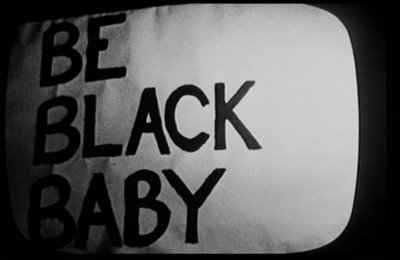
‘Be Black, Baby’ offers a different model of criticality for the theatre because it circumvents the obvious pitfalls of the modernist dialectical model. In this context, it is important to mention that the play dealt with here is part of a film and is, therefore, only ever presented through the mediation of cinema. The idea that the theatre can offer an authentic experience of blackness is even more absurd since it is doubly removed, through cinematic framing, from ‘life’. In the long scenes devoted to the play in Hi Mom!, the camera assumes a very active role, buzzing around the actors and the audience as if it too were a character. In some shots, the action of the actors is obscured from view, while others are too dark for the viewer to see clearly, mimicking the style of cinéma vérité. Stylised filmic interventions are also used in a deliberately noticeable manner. De Palma uses sharp cuts and dynamic angles and, more importantly, direct documentary-style interviews with members of the audience. The relationship between theatre and cinema is of course not coincidental in Hi Mom!.
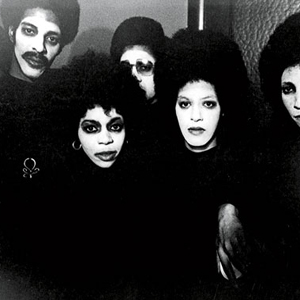
Benjamin describes Brecht’s epic theatre as similar to film, full of cuts, gaps and transitions from one scene to the next. These gaps are there, as mentioned earlier, for the audience to reflect on what it is being shown but also for the actor who also can find a distance from the character portrayed. ‘[A]n actor’, writes Benjamin: ‘should reserve for himself the possibility of stepping out of character artistically… [and] insist on portraying a man who reflects about his part’. [7] Brecht sees the actor as caught in a dialectical relationship with the subject he or she portrays, a relationship in which each produces the other. Rather than the complete and neutral convergence of the character and the actor, the Brechtian actor sets two types of performances one against the other, one of action and one of contemplation. But, Benjamin adds, this is not akin to the liberal play of possible identities that is the transgression permitted by the system. Brecht’s actors are not asked to identify with a different position in a way that is tolerable and inoffensive like (Benjamin’s example) a devout husband and father portraying Don Juan. Here, the actions of the characters on stage contradict completely the ethical judgment of the actors: a German actor in exile who is asked to assume the character of a murderous Nazi SS officer, for example.
De Palma teases out of this relationship between theatre and cinema an even more direct political significance. The main protagonist of the film, Vietnam veteran John Rubin (the police man who arrives to intervene in the chaos ensuing from the play, ‘Be Black, Baby’), seeks to establish his relationship to his surroundings through the mediation of the lens. While he takes an almost passive role in his own life, the camera dictates all his artistic, economic, sexual and social engagements with the city he returns to from the first truly ‘live’ (…on you television screen) war in history. In the first part of the film, for example, Rubin is attempting to create a new brand of pornography (or art) by spying on and filming the intimate lives of his neighbours. But Hi Mom! is not another Hollywood film moralising against the corrupting power of the media. Rubin’s passivity introduces a new type of political subject: a person, or even simply a body, who records the actions of others via technology and is captured by others in a similar way. He is a post-Foucauldian panoptic subject who captures other subjects with his gaze at the same time that these technologies of ordering through observation operate on him. Thus, the character’s agency is not derived here from a liberal difference, from actions or ideas that are set apart and against other ones. Instead, agency is achieved through mimesis: copying and reproducing the world, reordering it through looking.
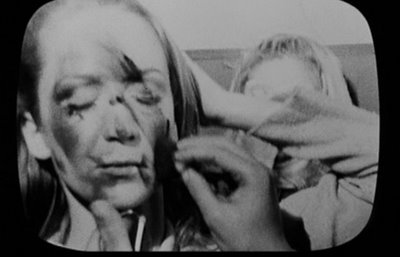
Similarly, the performers of ‘Be Black, Baby’ don’t inhabit characters but rather mimic stereotypes. The effect of their performance does not rely on the liveness of the experience. It is enough for their audience to serve as proxies for us because we don’t need to be convinced by this performance. Instead the film asks us to question any performance of racial authenticity. At the same time, it is literally impossible to separate the performers from their acting: are the actors antagonistic towards the audience because they are black militants encountering members of the hegemony or are they simply enacting the role of the aggressors outside the theatre (such as, the police, cultural and educational institutions)? ‘Be Black, Baby’ does not allow for ethical stability and the positions articulated by the actors cannot be open to debate and deliberation. Benjamin argues that identification with your tormentor is impossible, but the actors here are shown enjoying the subversive assuming of the role of hegemony and we are left incapable of the ethical judgment asked for by Brecht: can we approve of the sexual assault of audience members in the name of artistic freedom? If members of the audience are told that they are actors too now, do they stop performing once they leave the theatre?
‘Be Black, Baby’ may have been intended as a satire, but it leaves the viewer with a lot of uncomfortable questions. The audience of the play might learn little from the experience, but for us, the audience of the film, there is nowhere to hide: we see ourselves reflected in their smug admiration for the experience they’ve just had and that response is foreclosed for us. The avoidance of an ethical ground forces a new split into the political map whose existing oppositions are complicit with racial inequality. The racist position, that there is an essential biological difference between races, is obviously questioned here. The performative reversal of behaviours (when black actors in white faces become racist aggressors) clearly demonstrates how cultural and political differences are produces as exactly that – non-essentialist social behavior. But, the other position of mainstream American society in the late 1960s, that of the liberal audience who, from a position of sympathy, wishes to adopt the otherness of black culture as ‘cool’, is also challenged and exposed as racist. If the play in De Palma’s film is an illustration that the otherness of African Americans is produced as a direct result of the power structures in which they operate and if the behaviour of the audience confirms this, then both the positive-liberal and negative-racist understandings of this otherness are exposed as political fantasies that ultimately support inequality. When the liberal and the racist are grouped together a new political fissure opens up, this time not between the admirers and debasers of black culture but between an understanding of race as an inherent quality of the individual and the understanding of race as a performance built on socio-political signifiers.
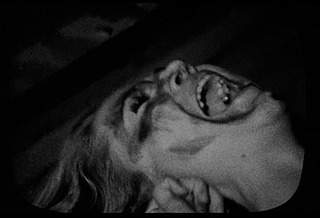
The type of encounter theatre depicted by De Palma stems from the same tradition that Rancière blames for the survival of the Platonic suspicion towards representation. As such De Palma’s theatrical model presented in ‘Be Black, Baby’ pairs the immersive theatre of cruelty with anti-theatrical Brechtian techniques, at once producing a realism that transgresses the boundaries of art and life and imposing a critical distance and awareness of artifice on participants. But instead of reasserting the dialectic of the theatre and lived reality, De Palma’s theatre attacks the assumptions underlying both the audience’s engagement with this representation of race relations and the tenability of their politics outside the context of the theatre. ‘Be Black, Baby’ quickly dismisses the theatrical engagement with the gap between the everyday and representation. Because what is represented on stage here in ‘documentary’ style is in fact the stereotype of an ethnic group and because it is performed by the audience rather then the actors, there is never any expectation of authenticity or suspension of disbelief. The white middle class audience knows full well that the suggestion that it can somehow be magically transformed into poor black people simply by applying paint to their faces is absurd – almost as ridiculous as the liberal idea that skin colour does not matter in the American society of the late 60s. Instead of this engagement with authenticity and artifice, the play forces us to locate the tension elsewhere, not in the relationship of the stage and its double but between the different types of performances that are fighting over the theatricality of public space or the performativity of everyday life.
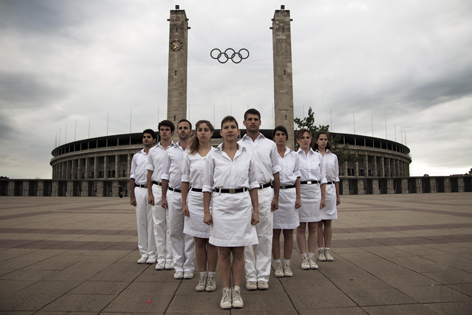
We can see a similar logic at work in the performances of the Israeli art group, Public Movement, whose motto states: ‘the army did not demonstrate sufficient creativity’. Appearing in dress uniform, they mimic state rallies and folk dancing, holding hands in a circle, crossing their feet, rearranging themselves into a marching phalanx, giving speeches and singing in city squares. These acts are often juxtaposed with car crashes, riots and terrorist attacks, presented in an equally dispassionate, stylised fashion. Here, again, the point is not to establish a critical distance from the action, which is presented as a kind of ritual and really does function in the same way as an official ceremony. We are not invited to view the appropriation of militaristic choreography as ironic, nor are we ever comfortable in succumbing to its seduction. But by juxtaposing Zionist state aesthetics with collective trauma, Public Movement reveals both to be equally ritualised in the responses they elicit. The unity of the performances that govern our movements in public and the private emotions we associate with them is split from within to the point where we can no longer be certain of the boundaries between self determination and social construction. The stage is not shown to be any more or less artificial than the social constructs being portrayed and no gap opens between performers and their actions: in fact, Public Movement have been accused of being ‘IDF propaganda minions’. [8] Yet the kind of propaganda they seem to manifest is also curiously dated, at odds both with the violent content of their work and with the post-ideological façade of the state in the name of which they purport to speak. Much like the band Crime, whose 1979 performance at the San Quentin prison saw them wearing uniforms identical to those worn by the guards policing their audience, Public Movement send mixed signals that lay bare tensions pre-existing in the unacknowledged performances they re-enact.
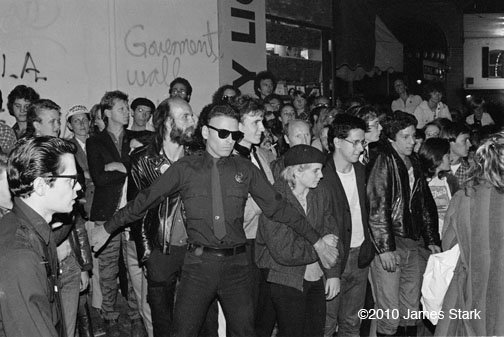
If the move we describe here rejects the established dialectical procedures of the avant garde that have lost their criticality, it is vital to think specifically how this proposal could rejuvenate the potential of theatre against the developments in post-Fordist labour mentioned above. The alienated distance that Brecht wanted to create for his audiences in order to invite a deconstruction of political structures is the prevailing mode of late capitalist production. A distance, even cynicism, is assumed as a given in this system: in its purest form, the self-motivated, self-managed ‘portfolio career’ of the creative industries, the post-Fordist labourer exploits him- or herself. One is literally one’s own boss and, at the same time, still a worker. The power that operates on the worker is assimilated into the psyche and as such disappears from view. The image of the factory, the power station or the slum, which served as concrete illustrations of the battleground between different classes in the first half of the 20th century, have also disappeared from this landscape to be replaced by the translucence of digital technology. This is disappearance is conveyed in countless science fiction films: in Minority Report, for example, the panoptic machine of the police is a transparent board of liquid and malleable digital information.
If the architecture of power melts away in the new creative cities of post-Fordism, theatre can make it concrete again by making present the explicit ideology that is treated as abject by late capitalism. We might not be able to escape dialectical critique altogether but the dialectic we are proposing here does not require an inherently weak position external to power with which to address power. We do not need to expose the corruption or immorality of power, facts of which we are all cynically aware and which change nothing. An exaggeration of the performance of the already highly theatricalised rites and rituals that we inhabit daily is able to concretise the postulations of life-style gurus, managerial help books and psych-lite literature as ideological manifestos, embodying the contradictions that sustain them beyond the point of sustainability and splitting the totality of this world in two.
[1] Benjamin, Walter, “What is Epic Theatre”, Illuminations, London: Fontana, 1992, p. 150.
[2] Ranciere, Jacques, “The Emancipated Spectator”, Artforum, March, 2007.
[3] Badiou, Alain, “One Divides itself into Two”, in: Lenin Reloaded: Toward a Politics of Truth [Sebastian Budgen, Eustache Kouvélakis and Slavoj Žižek - eds.], Durham, NC: Duke University Press, 2007, p. 11.
[4] Anonymous, “The Dialectical Mode: With Regard to Mao Zedong and Problems of Strategy in China’s Revolutionary War” [Bruno Bosteels – tr.], in: Positions, Duke University Press, 13:3, Winter, 2005, p. 666-7. Originally in La Distance Politique, issue 3, May, 1992. Despite texts appearing anonymously in this publication, the essay has been widely ascribed to Badiou.
[5] Ibid., p. 667
[6] Mao, Zedong “Talk On Questions Of Philosophy, August 18, 1964”, available at: http://www.marxists.org/reference/archive/mao/selected-works/volume-9/mswv9_27.htm [accessed 23.05.2011]
[7] Benjamin, Walter, “What is Epic Theatre”, p.150.
[8] Miller, Daniel, “Performing Politics for Germany”, Frieze, 13.7.2009, available at: http://blog.frieze.com/performing_politics_for_germany/ [accessed 27.3.12]